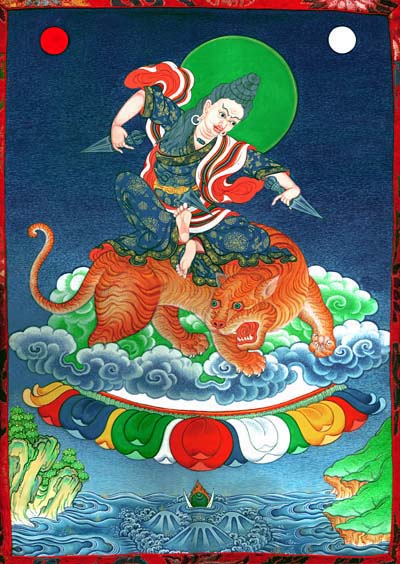
Jomo Pema ’ö-Zér
Jomo Pema ’ö-Zér Dri’mèd Yingma
Jomo Pema ’ö-Zér Dri’mèd Yingma (Jo mo pad ma ’od zer dri ’med dByings ma – Lady Lotus Light Rays in Immaculate Space, 1839-1902) was an incarnation of Tashi Chhi’drèn (mon mo bKra shis khyi’dren).
Tashi Chhi’drèn was born in the region of Mön, on the Nepalese border with Tibet at a place called Mön Tsa’og. She was one of the major sang-yums of Padmasambhava. She manifested as the tigress consort of Dorje Tröllö (rDo rJe gro lod – one of the eight manifestations of Padmasambhava).
Jomo Pema ’ö-Zér’s sang-yab or spiritual consort was Rang-rig Togden, and together, they were the mother and father of Khyungchen Aro Lingma. Jomo Pema ’ö-Zér and Rang-rig Togden were therefore the grandparents of Aro Yeshé (the previous incarnation of Ngak’chang Rinpoche).
Jomo Pema ’ö-Zér was primarily a Dzogchen long-dé master – but she was also an accomplished phurba master. It is said that her phurba vibrated when she sang phurba mantra. She is always shown in wrathful demeanour with a phurba in her belt – and also in her left and right hands. There is a strong line of Dorje Phurba and Dorje Tröllö practice within the Aro gTér as both Jomo Pema ’ö-Zér and Jomo Chhi’mèd Pema were phurba masters. All the major female lineage holders have had Dorje Tröllö as Lama, Dorje Phurba as Yidam, and Takdong (sTak gDong dPa bo) as Pawo. Aro Yeshé had Dorje Tröllö as Lama, Dorje Phurba as Yidam, and Green Seng-gé Dongma (seng ge gDog lJang)as Khandro.
Khyungchen Aro Lingma described her mother—Jomo Pema ’ö-Zér—as an emanation of Tsogyel Tröllö, and said that no one could meet her gaze, even though she was never wrathful in terms of how she related with people. Her wrathful demeanour seemed entirely of another dimension of experience and was only observed by Khyungchen Aro Lingma and Rang-rig Togden when they were in the presence of Jomo Pema ’ö-Zér whilst meditating. It was then that she appeared utterly terrifying.
Jomo Pema ’ö-Zér wears the Dzogchen blue chuba and is draped with the red, white, and blue shawl of the gö-kar chang-lo’i dé.
